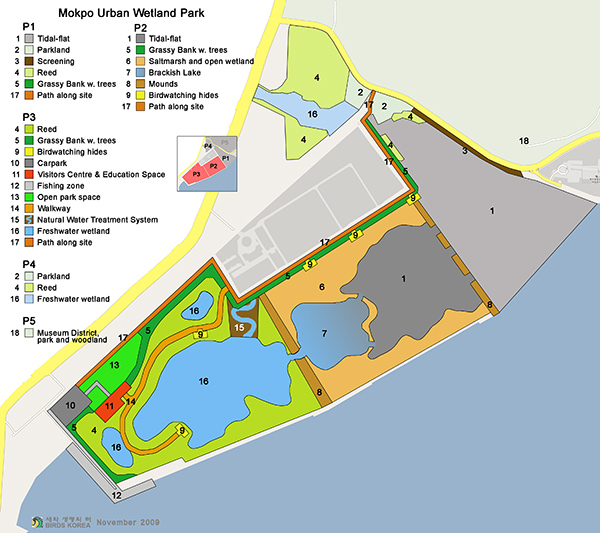Birds Korea works through the three inter-related fields of (1) Research, (2) Planning and design, and (3) Education and Awareness-raising activities. Our organisation contains staff and members with a broad range of skills and experience in all three fields, enabling us to conduct counts, assess habitats, analyse data, and develop or contribute to basic plans and designs for site conservation and enhancement (e.g. for the Ulseuk Island Restoration project in Busan; the Busan Citizen’s Park development; and as proposed in late 2009 as consultant for an eco-park/bird park in Incheon City). These projects we are then able to promote and explain through presentations, education programs and through our websites (in Korean and English), which attract over 1000 unique visitors daily.
At the Mokpo Namhang Urban wetland (an area of 50ha, containing a small estuary, reed-bed and two reclamation lagoons which are presently being in-filled), Birds Korea research has included regular bird counts and the analysis of three years of count data. In 2008, we also funded a basic study of the vegetation of the site (conducted by researchers from the Island and Culture Institute of Mokpo University).
Based on this research and on much valuable discussion with local stakeholders, organisations and decision-makers, as well as with leading experts (including specialists from the UK’s RSPB whom we invited to the site in 2007 and 2008), we have developed a basic plan for the enhancement of the Mokpo Namhang Urban Wetland. We are now proposing this basic plan for consideration by Mokpo City. We believe that with appropriate design and management, the Namhang wetland could over time become the nation’s first wildlife-rich wetland urban park (“The Mokpo Urban Wetland Park”).
As envisaged, the “The Mokpo Urban Wetland Park” would contain five areas (P1, P2, P3, P4 and P5), with P1-P4 made up of wetland habitats and P5 the adjacent area, including the Museum, Art and Culture District.
Through enhancing existing wildlife values in P1-P4 (by improving habitat and by zoning the area through e.g. planting and earth bank construction in order to reduce disturbance to sensitive species) the Park would provide multiple benefits for Mokpo City and citizens, including:
Providing an outstanding area for environmental education and recreation, within easy walking distance of the existing Museum and Culture District;
Improving water quality (through the creation of natural water-treatment ponds – a research and educational asset for the city);
Further improving Mokpo City’s attractiveness to tourists, while supporting the city’s efforts to achieve genuinely sustainable development.
We welcome inquiries, feedback and further support – For birds and For people.




